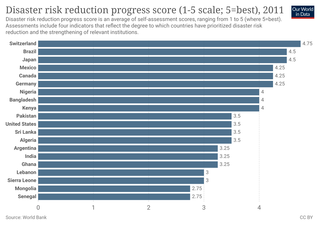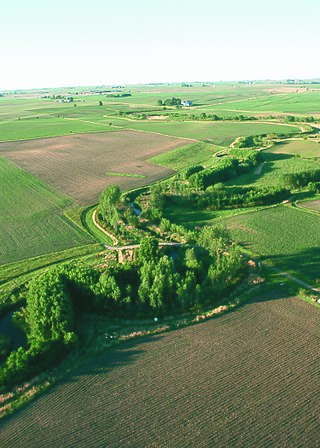Related Research Articles
A vulnerability assessment is the process of identifying, quantifying, and prioritizing the vulnerabilities in a system. Examples of systems for which vulnerability assessments are performed include, but are not limited to, information technology systems, energy supply systems, water supply systems, transportation systems, and communication systems. Such assessments may be conducted on behalf of a range of different organizations, from small businesses up to large regional infrastructures. Vulnerability from the perspective of disaster management means assessing the threats from potential hazards to the population and to infrastructure. It may be conducted in the political, social, economic or environmental fields.

Effects of climate change are well documented and growing for Earth's natural environment and human societies. Changes to the climate system include an overall warming trend, changes to precipitation patterns, and more extreme weather. As the climate changes it impacts the natural environment with effects such as more intense forest fires, thawing permafrost, and desertification. These changes can profoundly impact ecosystems and societies, and can become irreversible once tipping points are crossed.
Economic analysis of climate change is about using economic tools and models to calculate the magnitude and distribution of damages caused by climate change. It can also give guidance for the best policies for mitigation and adaptation to climate change from an economic perspective. There are many economic models and frameworks. For example, in a cost–benefit analysis, the trade offs between climate change impacts, adaptation, and mitigation are made explicit. For this kind of analysis, integrated assessment models (IAMs) are useful. Those models link main features of society and economy with the biosphere and atmosphere into one modelling framework. The total economic impacts from climate change are difficult to estimate. In general, they increase the more the global surface temperature increases. Economic analysis also looks at the economics of climate change mitigation.

Climate change adaptation is the process of adjusting to the effects of climate change. These can be both current or expected impacts. Adaptation aims to moderate or avoid harm for people, and is usually done alongside climate change mitigation. It also aims to exploit opportunities. Humans may also intervene to help adjustment for natural systems. There are many adaptation strategies or options. They can help manage impacts and risks to people and nature. The four types of adaptation actions are infrastructural, institutional, behavioural and nature-based options.

Disaster risk reduction (DRR) is an approach for planning and taking steps to make disasters less likely to happen, and less damaging when they do happen. DRR aims to make communities stronger and better prepared to handle disasters. When DRR is successful, it decreases the vulnerability of communities because it mitigates the effects of disasters. This means DRR can reduce the severity and number of risky events. Since climate change can increase climate hazards, DRR and climate change adaptation are often looked at together in development efforts.
Climate risk is the potential for problems for societies or ecosystems from the impacts of climate change. The assessment of climate risk is based on formal analysis of the consequences, likelihoods and responses to these impacts. Societal constraints can also shape adaptation options. There are different values and preferences around risk, resulting in differences of risk perception.

In ecology, resilience is the capacity of an ecosystem to respond to a perturbation or disturbance by resisting damage and subsequently recovering. Such perturbations and disturbances can include stochastic events such as fires, flooding, windstorms, insect population explosions, and human activities such as deforestation, fracking of the ground for oil extraction, pesticide sprayed in soil, and the introduction of exotic plant or animal species. Disturbances of sufficient magnitude or duration can profoundly affect an ecosystem and may force an ecosystem to reach a threshold beyond which a different regime of processes and structures predominates. When such thresholds are associated with a critical or bifurcation point, these regime shifts may also be referred to as critical transitions.

The Potsdam Institute for Climate Impact Research is a German government-funded research institute addressing crucial scientific questions in the fields of global change, climate impacts, and sustainable development. Ranked among the top environmental think tanks worldwide, it is one of the leading research institutions and part of a global network of scientific and academic institutions working on questions of global environmental change. It is a member of the Leibniz Association, whose institutions perform research on subjects of high relevance to society.
In political ecology and environmental policy, climate governance is the diplomacy, mechanisms and response measures "aimed at steering social systems towards preventing, mitigating or adapting to the risks posed by climate change". A definitive interpretation is complicated by the wide range of political and social science traditions that are engaged in conceiving and analysing climate governance at different levels and across different arenas. In academia, climate governance has become the concern of geographers, anthropologists, economists and business studies scholars.

Climate change and poverty are deeply intertwined because climate change disproportionally affects poor people in low-income communities and developing countries around the world. The impoverished have a higher chance of experiencing the ill-effects of climate change due to the increased exposure and vulnerability. Vulnerability represents the degree to which a system is susceptible to, or unable to cope with, adverse effects of climate change including climate variability and extremes.

Urban resilience has conventionally been defined as the "measurable ability of any urban system, with its inhabitants, to maintain continuity through all shocks and stresses, while positively adapting and transforming towards sustainability".

Climate change in Africa is an increasingly serious threat as Africa is among the most vulnerable continents to the effects of climate change. Some sources even classify Africa as "the most vulnerable continent on Earth". Climate change and climate variability will likely reduce agricultural production, food security and water security. As a result, there will be negative consequences on people's lives and sustainable development in Africa.
Vulnerability refers to "the quality or state of being exposed to the possibility of being attacked or harmed, either physically or emotionally." The understanding of social and environmental vulnerability, as a methodological approach, involves the analysis of the risks and assets of disadvantaged groups, such as the elderly. The approach of vulnerability in itself brings great expectations of social policy and gerontological planning. Types of vulnerability include social, cognitive, environmental, emotional or military.

In the fields of engineering and construction, resilience is the ability to absorb or avoid damage without suffering complete failure and is an objective of design, maintenance and restoration for buildings and infrastructure, as well as communities. A more comprehensive definition is that it is the ability to respond, absorb, and adapt to, as well as recover in a disruptive event. A resilient structure/system/community is expected to be able to resist to an extreme event with minimal damages and functionality disruptions during the event; after the event, it should be able to rapidly recovery its functionality similar to or even better than the pre-event level.
Climate resilience is a concept to describe how well people or ecosystems are prepared to bounce back from certain climate hazard events. The formal definition of the term is the "capacity of social, economic and ecosystems to cope with a hazardous event or trend or disturbance". For example, climate resilience can be the ability to recover from climate-related shocks such as floods and droughts. Methods of coping include suitable responses to maintain relevant functions of societies and ecosystems. To increase climate resilience means one has to reduce the climate vulnerability of people and countries. Efforts to increase climate resilience include a range of social, economic, technological, and political strategies. They have to be implemented at all scales of society, from local community action all the way to global treaties.
Community resilience is the sustained ability of a community to use available resources to respond to, withstand, and recover from adverse situations. This allows for the adaptation and growth of a community after disaster strikes. Communities that are resilient are able to minimize any disaster, making the return to normal life as effortless as possible. By implementing a community resilience plan, a community can come together and overcome any disaster, while rebuilding physically and economically.

Nature-based solutions is the sustainable management and use of natural features and processes to tackle socio-environmental issues. These issues include for example climate change, water security, food security, preservation of biodiversity, and disaster risk reduction. Through the use of NBS healthy, resilient, and diverse ecosystems can provide solutions for the benefit of both societies and overall biodiversity. The 2019 UN Climate Action Summit highlighted nature-based solutions as an effective method to combat climate change. For example, NBS in the context of climate action can include natural flood management, restoring natural coastal defences, providing local cooling, restoring natural fire regimes.

Climate change in Greenland is affecting the livelihood of the Greenlandic population. Geographically Greenland is situated between the Arctic and the Atlantic Ocean, with two thirds of the island being north of the Arctic Circle. Since the middle of the 20th century, the Arctic has been warming at about twice the global rate. Rising temperatures put increasing pressure on certain plant and tree species and contribute to Greenland's melting ice sheet. This affects and changes the livelihood of the Greenlandic population, particularly the Greenlandic Inuit, which make up to 80 percent of the total population. Besides the decline of fish stocks, the country's landscape is changing: the melting ice reveals minerals, oil and gas. This has attracted interest from local and foreign investors for potential resource extraction. As new industries are accompanied by new job opportunities and potential wealth, lifestyles are changing. Greenland is in transition, in terms of biophysical as well as cultural and social conditions.

Sustainable Development Goal 13 is to limit and adapt to climate change. It is one of 17 Sustainable Development Goals established by the United Nations General Assembly in 2015. The official mission statement of this goal is to "Take urgent action to combat climate change and its impacts". SDG 13 and SDG 7 on clean energy are closely related and complementary.

Climate change vulnerability is a concept that describes how strongly people or ecosystems are likely to be affected by climate change. Its formal definition is the "propensity or predisposition to be adversely affected" by climate change. It can apply to humans and also to natural systems. Issues around the capacity to cope and adapt are also part of this concept. Vulnerability is a component of climate risk. Vulnerability differs within communities and also across societies, regions, and countries. It can increase or decrease over time.
References
- ↑ IPCC (2014). "Glossary" (PDF). Intergovernmental Panel on Climate Change.
- ↑ Vincent, Katharine (2007). "Uncertainty in adaptive capacity and the importance of scale". Global Environmental Change. 17 (1): 12–24. doi:10.1016/j.gloenvcha.2006.11.009.
- ↑ Gunderson, Lance (2000-11-01). "Ecological Resilience–In Theory and Application". Annual Review of Ecology and Systematics. 31: 425–439. doi:10.1146/annurev.ecolsys.31.1.425.
- ↑ "AR5 Synthesis Report: Climate Change 2014 — IPCC" . Retrieved 2019-12-18.
- ↑ Jones, Lindsey; Ludi, Eva; Jeans, Helen; Barihaihi, Margaret (2019-01-02). "Revisiting the Local Adaptive Capacity framework: learning from the implementation of a research and programming framework in Africa" (PDF). Climate and Development. 11 (1): 3–13. Bibcode:2019CliDe..11....3J. doi:10.1080/17565529.2017.1374237. ISSN 1756-5529. S2CID 151242240.
- ↑ Jones, Ludi and Levine, Lindsey, Eva and Simon (December 2010). "Towards a characterisation of adaptive capacity: a framework for analysing adaptive capacity at the local level" (PDF). ODI: 8. Archived from the original (PDF) on 2020-01-28. Retrieved 2019-10-02– via Overseas Development Institute.
{{cite journal}}: CS1 maint: multiple names: authors list (link) - ↑ Taylor, Douglas R.; Aarssen, Lonnie W.; Loehle, Craig (1990). "On the Relationship between r/K Selection and Environmental Carrying Capacity: A New Habitat Templet for Plant Life History Strategies". Oikos. 58 (2): 239–250. Bibcode:1990Oikos..58..239T. doi:10.2307/3545432. ISSN 0030-1299. JSTOR 3545432.
- ↑ Oizumi, Ryo; Kuniya, Toshikazu; Enatsu, Yoichi (2016-06-23). "Reconsideration of r/K Selection Theory Using Stochastic Control Theory and Nonlinear Structured Population Models". PLOS ONE. 11 (6): e0157715. Bibcode:2016PLoSO..1157715O. doi: 10.1371/journal.pone.0157715 . ISSN 1932-6203. PMC 4919082 . PMID 27336169.
- ↑ Gunderson, L.H. and C.S. Holling, editors. Panarchy: Understanding Transformations in Human and Natural Systems. Island Press, Washington.
- ↑ Allen, Craig; Holling, C.s (2010-09-01). "Novelty, Adaptive Capacity, and Resilience". Ecology and Society. 15 (3). doi: 10.5751/ES-03720-150324 .
- ↑ IPCC, 2022: Annex II: Glossary [Möller, V., R. van Diemen, J.B.R. Matthews, C. Méndez, S. Semenov, J.S. Fuglestvedt, A. Reisinger (eds.)]. In: Climate Change 2022: Impacts, Adaptation and Vulnerability. Contribution of Working Group II to the Sixth Assessment Report of the Intergovernmental Panel on Climate Change [H.-O. Pörtner, D.C. Roberts, M. Tignor, E.S. Poloczanska, K. Mintenbeck, A. Alegría, M. Craig, S. Langsdorf, S. Löschke, V. Möller, A. Okem, B. Rama (eds.)]. Cambridge University Press, Cambridge, UK and New York, NY, USA, pp. 2897–2930, doi:10.1017/9781009325844.029
- ↑ Gupta, Joyeeta; Termeer, Catrien; Klostermann, Judith; Meijerink, Sander; van den Brink, Margo; Jong, Pieter; Nooteboom, Sibout; Bergsma, Emmy (1 October 2010). "The Adaptive Capacity Wheel: a method to assess the inherent characteristics of institutions to enable the adaptive capacity of society". Environmental Science & Policy. 13 (6): 459–471. doi:10.1016/j.envsci.2010.05.006. hdl: 1765/20798 . ISSN 1462-9011.
- ↑ Brooks, N and Adger, WN (2005) Assessing and enhancing adaptive capacity. In: Adaptation Policy Frameworks for Climate Change: Developing Strategies, Policies and Measures. Cambridge University Press, Cambridge, pp. 165–181.
- ↑ Smit, Barry; Wandel, Johanna (2006). "Adaptation, adaptive capacity and vulnerability" (PDF). Global Environmental Change. 16 (3): 282–292. doi:10.1016/j.gloenvcha.2006.03.008. S2CID 14884089. Archived from the original (PDF) on 24 June 2010. Retrieved 29 August 2010.
- ↑ Ara Begum, R., R. Lempert, E. Ali, T.A. Benjaminsen, T. Bernauer, W. Cramer, X. Cui, K. Mach, G. Nagy, N.C. Stenseth, R. Sukumar, and P. Wester, 2022: Chapter 1: Point of Departure and Key Concepts. In: Climate Change 2022: Impacts, Adaptation and Vulnerability. Contribution of Working Group II to the Sixth Assessment Report of the Intergovernmental Panel on Climate Change [H.-O. Pörtner, D.C. Roberts, M. Tignor, E.S. Poloczanska, K. Mintenbeck, A. Alegría, M. Craig, S. Langsdorf, S. Löschke, V. Möller, A. Okem, B. Rama (eds.)]. Cambridge University Press, Cambridge, UK and New York, NY, USA, pp. 121–196, doi:10.1017/9781009325844.003
- ↑ Juhola, Sirkku; Peltonen, Lasse; Niemi, Petteri (2013), "Assessing Adaptive Capacity to Climate Change in European Regions", European Climate Vulnerabilities and Adaptation, John Wiley & Sons, Ltd, pp. 113–130, doi:10.1002/9781118474822.ch7, ISBN 9781118474822
- ↑ Guillaume, Simonet; Alexia, Leseur (2019). "Barriers and drivers to adaptation to climate change—a field study of ten French local authorities". Climatic Change. 155 (4): [ page needed ]. doi:10.1007/s10584-019-02484-9. ISSN 0165-0009.
- 1 2 3 4 5 "IPCC - Intergovernmental Panel on Climate Change". archive.ipcc.ch. Retrieved 2024-04-08.
- ↑ "Poor and Vulnerable Countries Need Support to Adapt to Climate Change". IMF. 2022-03-23. Retrieved 2024-04-13.
- ↑ Moser, Susanne C.; Ekstrom, Julia A. (2010). "A framework to diagnose barriers to climate change adaptation". Proceedings of the National Academy of Sciences. 107 (51): 22026–22031. Bibcode:2010PNAS..10722026M. doi: 10.1073/pnas.1007887107 . PMC 3009757 . PMID 21135232. S2CID 7635031.
- ↑ Piggott-McKellar, A. E.; McNamara, K. E.; Nunn, P. D.; Watson, J. E. M. (2019-06-05). "What are the barriers to successful community-based climate change adaptation? A review of grey literature". Local Environment. 24 (4): 374–390. Bibcode:2019LoEnv..24..374P. doi:10.1080/13549839.2019.1580688.
- 1 2 Eisenack, Klaus; Moser, Susanne C.; Hoffmann, Esther; Klein, Richard J. T.; Oberlack, Christoph; Pechan, Anna; Rotter, Maja; Termeer, Catrien J. A. M. (October 2014). "Explaining and overcoming barriers to climate change adaptation". Nature Climate Change. 4 (10): 867–872. Bibcode:2014NatCC...4..867E. doi:10.1038/nclimate2350. ISSN 1758-6798.
- 1 2 Brooks ('first'), Adger ('second'), Nick ('first'), Neil ('second') (2004). "Assessing and Enhancing Adaptive Capacity": 165–181 – via Research Gate.
{{cite journal}}: Cite journal requires|journal=(help)CS1 maint: multiple names: authors list (link) - ↑ Barr, Stephanie L.; Lemieux, Christopher J. (2021-09-21). "Assessing organizational readiness to adapt to climate change in a regional protected areas context: lessons learned from Canada". Mitigation and Adaptation Strategies for Global Change. 26 (8): 34. Bibcode:2021MASGC..26...34B. doi:10.1007/s11027-021-09972-3. ISSN 1573-1596.
- ↑ Ford, James D.; King, Diana (2015-04-01). "A framework for examining adaptation readiness". Mitigation and Adaptation Strategies for Global Change. 20 (4): 505–526. Bibcode:2015MASGC..20..505F. doi:10.1007/s11027-013-9505-8. ISSN 1573-1596.
- 1 2 Greenwood, Lisa L.; Lin, Vicki; Abraham, Yewande S.; Schneider, Jennifer L. (January 2023). "Partnering for Climate Resilience: Exploring the Maturity of Private-Sector Efforts in the Great Lakes Region". Sustainability. 15 (19): 14105. doi: 10.3390/su151914105 . ISSN 2071-1050.